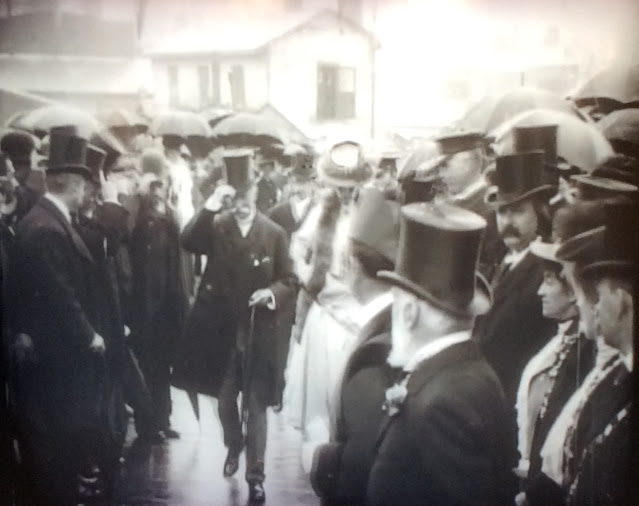Newport Rugby and Rodney Parade
Newport Rugby and Rodney Parade
1. Rodney Parade
 |
| Viscount Tredegar painted by George Frederick Harris (1910) Newport Museum and Art Gallery From the Marshes to the Salt Pool. |
In 1875, the Newport Athletic Club was created, and two years later they secured the use of land at Rodney Parade from Godrey Morgan 1st Vicount Tredegar, for their cricket, tennis, rugby and athletics teams. He called it Rodney Parade after his brother Charles Rodney Morgan (2 December 1828 – 14 January 1854). Charles Rodney Morgan was the first born son and was due to inherit the estate but died in 1854, in Marseilles. For more information click here - Charles Rodney Morgan
 |
| Clarke's Garden 1854 |
The Invincibles
From the start in 1874, Newport RFC quickly established themselves as the top team in Wales. In the first four seasons under the leadership of William Phillips Newport won all of their fixtures, playing 59 games, kicking 87 goals and scoring 148 tries, with only two goals and eight tries conceded. Challenges were thrown down to clubs outside of Wales. The most famous club in England – Blackheath, was invited to play at Rodney Parade in November 1879. This game was to end Newport’s invincibility. Newport were beaten by eight goals and four tries to nothing. The creation of a national team and the Welsh Rugby Union can be traced back to this game. Newport learnt from the Blackheath defeat, gaining lots of match play and learning to adapt their game against a wide variety of opponents. They would come back much stronger. The 1891-92 season was the start of the greatest period in the Club’s history. Newport were undefeated for the whole of that season and by 1897 had played 170 matches, winning 143, drawing 14 and only losing 13. It was a period of great captains, great play and great success. Never again have Newport had such a galaxy of great players. Newport RFC’s fame spread far and wide thanks to this fantastic team. In 1922-23 led by their magnificent forwards, Newport went through a season undefeated for the sixth time under the captaincy of Jack Wetter.
Here are some photographs which have been deposited in Newport Museum and Art Gallery as part of the collection. Arranged in date order - from box 4.
1. Newport Second XV 1890-91 |
2. 1892 at Oxford  |
 |
 |
 |
 |
International Rugby Matches
12.01.1884 – 1884 Home Nations Championship – Wales vs Scotland
04.02.1888 – 1888 Home Nations Championship – Wales vs Scotland
03.01.1891 – 1891 Home Nations Championship – Wales vs England
03.02.1894 – 1894 Home Nations Championship – Wales vs Scotland
09.01.1897 – 1897 Home Nations Championship – Wales vs England
25.03.1912 – Friendly - Wales vs France
140 years of Newport RFC
Into the new Millennium
Sharing the ground
Following the introduction of regional rugby union teams in Wales the Newport Gwent Dragons regional team was formed on 1 April 2003 and shared Rodney Parade with Newport RFC from then onwards. On 4 September 2007, it was announced that the Rodney Parade site was due to be redeveloped into a 15,000-capacity stadium by the beginning of the 2010–11 rugby union season. The redevelopment was backed by Newport City Council, Newport Unlimited, Newport RFC and Newport Gwent Dragons. The application received planning consent on 11 March 2009. The plan included construction of covered stands at the north and south ends and the provision of cover on the stretch of the west touchline terrace. In August 2010, it was announced that the target finish date for the first phase had been put back to the beginning of the 2011–12 rugby union season with the full redevelopment planned to take several years. The new east stand was opened in October 2011, and named the Bisley Stand for sponsorship purposes.
In May 2012, it was agreed that Newport County football club would move from Newport Stadium and play its home fixtures at Rodney Parade as part of an initial three-year deal, meaning that the stadium would host association football matches on a regular basis for the first time. In February 2013, Newport County agreed a further 10-year lease to play at Rodney Parade.
In the summers of 2013 and 2014, new drainage and irrigation systems were installed under the grass playing surface but despite that, serious drainage problems occurred at the end of 2016. Newport County's matches against Barnet on 3 September and Morercombe on 10 December were abandoned at half-time because the pitch was waterlogged and the English Football League stepped in to help identify the problem.
In March 2017, sale of the ground to the Welsh Rugby Union was agreed following a vote of Newport RFC shareholders. The takeover was completed on 27 June 2017 and work started to install a hybrid grass pitch for the 2017–18 rugby and football season.
In March 2021 Newport County were permitted by the EFL to move two home matches to Cardiff City Stadium due to the poor condition of the Rodney Parade pitch. The Dragons also switched three home matches to Cardiff. Scheduled pitch maintenance had been cancelled in Summer 2020 by the ground owners WRU due to the COVID- 19 pandemic.
Extra Information
See a blog written just before lockdown: click On the banks of the River Usk - a day in Newport
23 Feb 2020 by johndewhirst a football supporter from Bradford




Comments
Post a Comment